LGM-30 Minuteman III
Overview
| Specifications |
| Images |
| Sources and Resources |
 Five hundred Minuteman III missiles are deployed at four bases in the north- central United States: Minot AFB and Grand Forks AFB, North Dakota, Malmstrom AFB, Montana, and F. E. Warren AFB, Wyoming. Operational since 1968, the model "G" differs from the "F" in the third stage and reentry system. The third stage is larger and provides more thrust for a heavier payload. The payload, the Mark 12 reentry system, consists of a payload mounting platform, penetration aids, three reentry vehicles (RVs) and an aerodynamic shroud. The shroud protects the RVs during the early phases of flight. The mounting platform is also a "payload bus" and contains a restartable hypergolic rocket engine powered by hydrazine and nitrogen tetroxide. With this configuration, the RVs can be independently aimed at different targets within the missile's overall target area or "footprint". This concept is known as Multiple Independently Targeted Reentry Vehicles (MIRV).
Five hundred Minuteman III missiles are deployed at four bases in the north- central United States: Minot AFB and Grand Forks AFB, North Dakota, Malmstrom AFB, Montana, and F. E. Warren AFB, Wyoming. Operational since 1968, the model "G" differs from the "F" in the third stage and reentry system. The third stage is larger and provides more thrust for a heavier payload. The payload, the Mark 12 reentry system, consists of a payload mounting platform, penetration aids, three reentry vehicles (RVs) and an aerodynamic shroud. The shroud protects the RVs during the early phases of flight. The mounting platform is also a "payload bus" and contains a restartable hypergolic rocket engine powered by hydrazine and nitrogen tetroxide. With this configuration, the RVs can be independently aimed at different targets within the missile's overall target area or "footprint". This concept is known as Multiple Independently Targeted Reentry Vehicles (MIRV).
The LGM-30 Minuteman missiles are dispersed in hardened silos to protect against attack and connected to an underground launch control center through a system of hardened cables. Launch crews, consisting of two officers, perform around-the-clock alert in the launch control center. A variety of communication systems provide the National Command Authorities with highly reliable, virtually instantaneous direct contact with each launch crew. Should command capability be lost between the launch control center and remote missile launch facilities, specially-configured EC-135 airborne launch control center aircraft automatically assume command and control of the isolated missile or missiles. Fully qualified airborne missile combat crews aboard airborne launch control center aircraft would execute the NCA orders.
The Minuteman weapon system was conceived in the late 1950s and deployed in the early 1960s. Minuteman was a revolutionary concept and an extraordinary technical achievement. Both the missile and basing components incorporated significant advances beyond the relatively slow-reacting, liquid-fueled, remotely-controlled intercontinental ballistic missiles of the previous generation. From the beginning, Minuteman missiles have provided a quick-reacting, inertially guided, highly survivable component to America's nuclear Triad. Minuteman's maintenance concept capitalizes on high reliability and a "remove and replace" approach to achieve a near 100 percent alert rate.
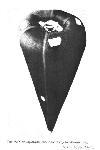 By the time the last Minuteman IIs of the 564th SMS were placed on strategic alert in the spring of 1967, significant progress had been made on the development of an even more advanced ICBM. The Minuteman III, using modernized Minuteman I and Minuteman II ground facilities, provided reentry vehicle and penetration aids deployment flexibility, increased payload, and improved survivability in a nuclear environment. Its liquid injection attitude control system with a fixed nozzle on an improved third stage motor increased the Minuteman's range and the Minuteman III reentry system could deploy penetration aids and up to three Mark 12 or Mark 12A multiple independently-targetable reentry vehicles. A liquid-fueled post-boost propulsion system maneuvered the missile prior to deployment of the reentry vehicles, while upgraded guidance system electronics enhanced computer memory and accuracy.
By the time the last Minuteman IIs of the 564th SMS were placed on strategic alert in the spring of 1967, significant progress had been made on the development of an even more advanced ICBM. The Minuteman III, using modernized Minuteman I and Minuteman II ground facilities, provided reentry vehicle and penetration aids deployment flexibility, increased payload, and improved survivability in a nuclear environment. Its liquid injection attitude control system with a fixed nozzle on an improved third stage motor increased the Minuteman's range and the Minuteman III reentry system could deploy penetration aids and up to three Mark 12 or Mark 12A multiple independently-targetable reentry vehicles. A liquid-fueled post-boost propulsion system maneuvered the missile prior to deployment of the reentry vehicles, while upgraded guidance system electronics enhanced computer memory and accuracy.
On 17 April 1970, an important Minuteman III milestone was reached when the first missile was placed in a silo assigned to the 741st Strategic Missile Squadron, Minot AFB, North Dakota. At the end of December, the 741st SMS became the first SAC Minuteman III squadron to achieve operational status.
Strategic Air Command expected Minuteman to play an important role in the command's force structure beyond the year 2000. To ensure the reliability and maintainability of the Minuteman force into the next century, the Air Force initiated a major Minuteman upgrade and modification program. Rivet MILE (Minuteman Integrated Life Extension Program) began 1 April 1985 at the 341st Strategic Missile Wing, Malmstrom AFB, Montana. This joint Strategic Air Command and Air Force Logistics Command effort was the largest single missile logistics program ever undertaken within the ICBM program.
Through state-of-the-art improvements, the Minuteman system has evolved to meet new challenges and assume new missions. Modernization programs have resulted in new versions of the missile, expanded targeting options, significantly improved accuracy and survivability. Today's Minuteman weapon system is the product of almost 35 years of continuous enhancement.
Peacekeeper missile deployment also affected the Minuteman force. As part of the strategic modernization program undertaken in 1982, Strategic Air Command deployed fifty Peacekeeper missiles in modified Minuteman III silos assigned to the 400th Strategic Missile Squadron, 90th Strategic Missile Wing, F.E. Warren AFB, Wyoming. Conversion began on 3 January 1986, when the first Minuteman came off alert, and the phaseout of the 400th SMS's Minuteman IIIs was completed on 11 April 1988.
The current Minuteman force consists of 530 Minuteman III's located at F.E. Warren Air Force Base, Wyo.; Malmstrom AFB, Mont.; Minot AFB, N.D.; and Grand Forks AFB, N.D. As a result of U.S. initiatives to cancel development programs for new intercontinental ballistic missiles and retire the Peacekeeper ICBM, Minuteman will become the only land-based ICBM in the Triad. To compensate for termination of the Small ICBM and Peacekeeper Rail Garrison programs, DOD will conduct an extensive life extension program to keep Minuteman viable beyond the turn of the century. These major programs include replacement of the aging guidance system, remanufacture of the solid-propellant rocket motors, replacement of standby power systems, repair of launch facilities, and installation of updated, survivable communications equipment and new command and control consoles to enhance immediate communications. Return to Top
 In order to meet warhead levels set by START II, the United States has decided to permanently DEMIRV Minuteman III missiles from their current capability to carry up to three reentry vehicles to a newly configured single reentry vehicle system once the treaty enters into force. "Downloading" Minuteman III missiles from three reentry vehicles to one lowers the military value of each missile; reduces the likelihood of any country expending resources to preemptively attack America's ICBM force; and decreases the probability of future US leaders being force into a "use or lose" position. For a downsized force of 500 single reentry vehicle Minuteman III to continue to be an effective deterrent force, the guidance replacement program will improve the needed accuracy and supportability that is inherent in a smaller missile force. Peacekeeper missiles will be deactivated by 2003, provided START II is ratified and enters into force. Ultimately, a total of 500 single RV Minuteman IIIs will be the nation's ICBM deterrent force through 2020.
In order to meet warhead levels set by START II, the United States has decided to permanently DEMIRV Minuteman III missiles from their current capability to carry up to three reentry vehicles to a newly configured single reentry vehicle system once the treaty enters into force. "Downloading" Minuteman III missiles from three reentry vehicles to one lowers the military value of each missile; reduces the likelihood of any country expending resources to preemptively attack America's ICBM force; and decreases the probability of future US leaders being force into a "use or lose" position. For a downsized force of 500 single reentry vehicle Minuteman III to continue to be an effective deterrent force, the guidance replacement program will improve the needed accuracy and supportability that is inherent in a smaller missile force. Peacekeeper missiles will be deactivated by 2003, provided START II is ratified and enters into force. Ultimately, a total of 500 single RV Minuteman IIIs will be the nation's ICBM deterrent force through 2020.
Specifications Return to Top |
|
| Primary function: | Intercontinental ballistic missile |
| Contractor: | Boeing Co. |
| Power plant: | Three solid-propellant rocket motors; first stage, Thiokol; second stage, Aerojet-General; third stage, United Technologies Chemical Systems Division |
| Thrust: | First stage, 202,600 pounds (91,170 kilograms) |
| Length: | 59.9 feet (18 meters) |
| Weight: | 79,432 pounds (32,158 kilograms) |
| Diameter: | 5.5 feet (1.67 meters) |
| Range: | 6,000-plus miles (5,218 nautical miles) |
| Speed: | Approximately 15,000 mph (Mach 23 or 24,000 kph) at burnout |
| Ceiling: | 700 miles (1,120 kilometers) |
| Guidance systems: | Inertial system: Autonetics Division of Rockwell International; ground electronic/security system: Sylvania Electronics Systems and Boeing Co. |
| Load: | Re-entry vehicle: General Electric MK 12 or MK 12A |
| Warheads: | Three (downloaded to one as required by the Washington Summit Agreement, June 1992) |
| Yield: | |
| Circular Error Probable: | |
| Unit cost: | $7 million |
| Date deployed: | June 1970, production cessation: December 1978 |
| Inventory: | Active force, 530; Reserve, 0; ANG, 0 |
| Operational Units: |
|



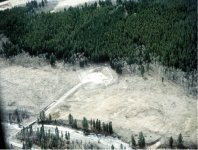
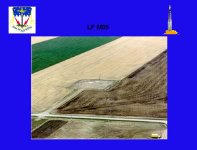
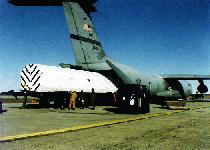

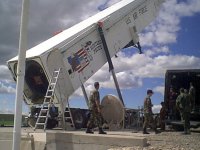
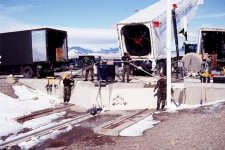

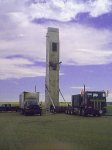
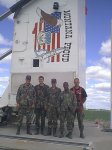


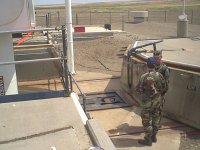
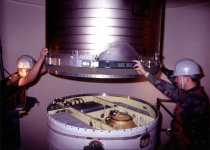
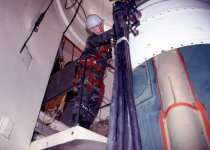

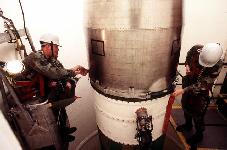


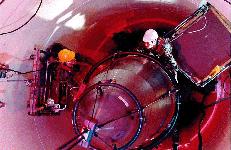


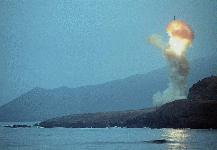
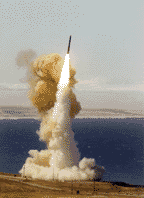
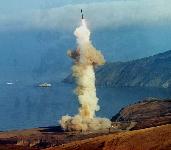
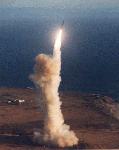



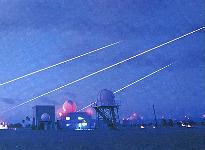
Sources and Resources Return to Top
- Last missile leaves North Dakota: Jun 10, 1998 (AFNS) -- After more than three decades on alert under North Dakota soil, the last of 150 missiles assigned to the 321st Missile Group was removed June 3 during a ceremony near Park River. With the departure of the last Minuteman III, located at Golf-15, the missile group moves one step closer to its inactivation July 2.
- Final Minuteman missile pulls out of Grand Forks , June 9, 1998 -- Missile handling personnel from the 321st Missile Group pulled the last Minuteman missile of 150 that were assigned. The removal took place June 3.
- Air Force taking steps to ensure Minuteman reliability Released: Jun 30, 1998 (AFNS) The Air Force Operational Test and Evaluation Center's Minuteman III Guidance Replacement Program [GRP] is intended to extend the service life of the Minuteman III missile systems through the year 2025.
- Vandenberg boasts four successful launches in last 48 days Released: Jun 30, 1998 (AFNS) - Two unarmed Minuteman III intercontinental ballistic missiles were launched at 1:01 and 5:46 a.m. Wednesday as part of the Air Force's test and evaluation program.
- AF Minuteman missiles undergo booster upgrades, Air Force Print News, 23 April 2001 -- A new Minuteman III was installed recently at launch facility Hotel-02 in Malmstrom's missile complex. The new system was a result of the Propulsion Replacement Program which provides replacements for all three of the solid propellant booster stages that make up the Minuteman III

